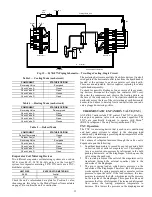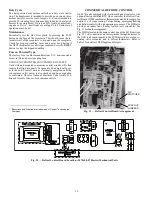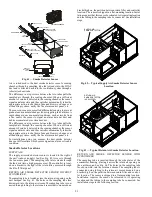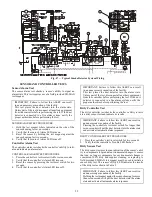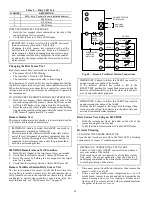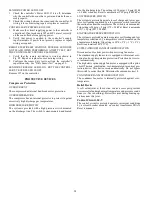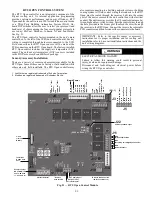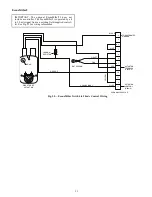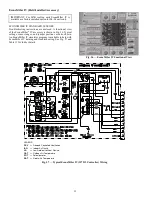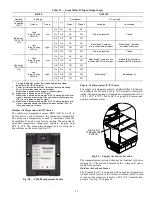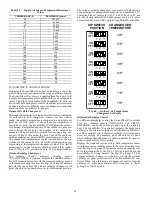
26
Table 9 — Dirty LED Test
DIRTY SENSOR TEST PROCEDURE
1. Hold the test magnet where indicated on the side of the
sensor housing for two seconds.
2. Verify that the sensor’s Dirty LED flashes.
Changing the Dirt Sensor Test
By default, sensor dirty test results are indicated by:
• The sensor’s Dirty LED flashing.
• The controller’s Trouble LED flashing.
• The controller’s supervision relay contacts toggle.
The operation of a sensor’s dirty test can be changed so that the
controller’s supervision relay is not used to indicate test results.
When two detectors are connected to a controller, sensor dirty
test operation on both sensors must be configured to operate in
the same manner.
TO CONFIGURE THE DIRTY SENSOR TEST OPERATION
1. Hold the test magnet where indicated on the side of the
sensor housing until the sensor’s Alarm LED turns on and
its Dirty LED flashes twice (approximately 60 seconds).
2. Reset the sensor by removing the test magnet then holding
it against the sensor housing again until the sensor’s Alarm
LED turns off (approximately 2 seconds).
Remote Station Test
The remote station alarm test checks a test/reset station’s abili
-
ty to initiate and indicate an alarm state.
SD-TRM4 Remote Alarm Test Procedure
1. Hold the test magnet to the target area for seven seconds.
2. Verify that the test/reset station’s Alarm LED turns on.
3. Reset the sensor by holding the test magnet to the target
area for 2 seconds.
4. Verify that the test/reset station’s Alarm LED turns off.
Remote Test/Reset Station Dirty Sensor Test
The test/reset station dirty sensor test checks the test/reset sta
-
tion’s ability to initiate a sensor dirty test and indicate the re
-
sults. It must be wired to the controller as shown in Fig. 48 and
configured to operate the controller’s supervision relay. For
more information, see “Dirty Sensor Test” on page 25.
Fig. 48 — Remote Test/Reset Station Connections
Dirty Sensor Test Using an SD-TRM4
1. Hold the test magnet where indicated on the side of the
sensor housing for two seconds.
2. Verify that the test/reset station’s Trouble LED flashes.
Detector Cleaning
CLEANING THE SMOKE DETECTOR
Clean the duct smoke sensor when the Dirty LED is flashing
continuously or sooner, if conditions warrant.
1. Disconnect power from the duct detector then remove the
sensor’s cover. See Fig. 49.
2. Using a vacuum cleaner, clean compressed air, or a soft
bristle brush, remove loose dirt and debris from inside the
sensor housing and cover. Use isopropyl alcohol and a
lint-free cloth to remove dirt and other contaminants from
the gasket on the sensor’s cover.
FLASHES
DESCRIPTION
1
0-25% dirty. (Typical of a newly installed detector)
2
25-50% dirty
3
51-75% dirty
4
76-99% dirty
IMPORTANT: Failure to follow this ALERT can result
in an unnecessary evacuation of the facility.
Changing the dirty sensor test operation will put the
detector into the alarm state and activate all automatic
alarm responses. Before changing dirty sensor test opera
-
tion, disconnect all auxiliary equipment from the control
-
ler and notify the proper authorities if connected to a fire
alarm system.
IMPORTANT: Failure to follow this ALERT can result in
an unnecessary evacuation of the facility.
This test places the duct detector into the alarm state. Unless
part of the test, disconnect all auxiliary equipment from the
controller before performing the test. If the duct detector is
connected to a fire alarm system, notify the proper authori
-
ties before performing the test.
IMPORTANT: Failure to follow this ALERT can result in
an unnecessary evacuation of the facility.
If the test/reset station’s key switch is left in the
RESET/TEST position for longer than seven seconds, the
detector will automatically go into the alarm state and acti
-
vate all automatic alarm responses.
IMPORTANT: Failure to follow this ALERT can result in
an unnecessary evacuation of the facility.
Holding the test magnet to the target area for longer than
seven seconds will put the detector into the alarm state and
activate all automatic alarm responses.
IMPORTANT: OPERATIONAL TEST ALERT
Failure to follow this ALERT can result in an unneces
-
sary evacuation of the facility.
If the smoke detector is connected to a fire alarm system,
first notify the proper authorities that the detector is
undergoing maintenance then disable the relevant circuit
to avoid generating a false alarm.
1
12
14
13
19
15
2
20
3
RESET/TEST
TROUBLE
POWER
ALARM
5
4
1
3
2
SD-TRM4
2
1
TB3
18 VDC (-)
18 VDC (-)
+
−
SUPERVISION
RELAY
CONTACTS [3]
WIRE MUST BE
ADDED BY
INSTALLER
SMOKE DETECTOR
CONTROLLER
AUXILIARY
EQUIPMENT
Содержание 547K
Страница 94: ...94 APPENDIX D WIRING DIAGRAMS Fig I 547K 04 06 Power Wiring Diagram 208 230 1 60 ...
Страница 95: ...95 APPENDIX D WIRING DIAGRAMS Fig J 547K 04 07 Power Wiring Diagram 208 230 3 60 ...
Страница 96: ...96 APPENDIX D WIRING DIAGRAMS Fig K 5047K 04 07 Power Wiring Diagram 460 575 3 60 ...

